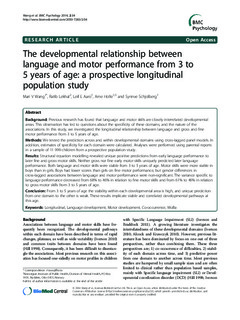| dc.contributor.author | Wang, Mari Vaage | |
| dc.contributor.author | Lekhal, Ratib | |
| dc.contributor.author | Aarø, Leif Edvard | |
| dc.contributor.author | Holte, Arne | |
| dc.contributor.author | Schjølberg, Synnve | |
| dc.date.accessioned | 2015-02-23T13:13:24Z | |
| dc.date.available | 2015-02-23T13:13:24Z | |
| dc.date.issued | 2014 | |
| dc.identifier.citation | Wang, M. V., Lekhal, R., Aarø, L. E., Holte, A. & Schjølberg, S. (2014). The developmental relationship between language and motor performance from 3 to 5 years of age: a prospective longitudinal population study. BMC Psychology, 2, 10. doi: 10.1186/s40359-014-0034-3 | nb_NO |
| dc.identifier.issn | 2050-7283 | |
| dc.identifier.uri | http://hdl.handle.net/11250/277192 | |
| dc.description | This is an Open Access article originally published in BMC Psychology and distributed under the terms of the Creative Commons Attribution License (http://creativecommons.org/licenses/by/2.0), which permits unrestricted use, distribution, and reproduction in any medium, provided the original work is properly credited. You can access the article on publisher's website by following this link: http://www.biomedcentral.com/2050-7283/2/34 | nb_NO |
| dc.description.abstract | Background: Previous research has found that language and motor skills are closely interrelated developmental
areas. This observation has led to questions about the specificity of these domains, and the nature of the
associations. In this study, we investigated the longitudinal relationship between language and gross and fine
motor performance from 3 to 5 years of age.
Methods: We tested the prediction across and within developmental domains using cross-lagged panel models. In
addition, estimates of specificity for each domain were calculated. Analyses were performed using parental reports
in a sample of 11 999 children from a prospective population study.
Results: Structural equation modelling revealed unique positive predictions from early language performance to
later fine and gross motor skills. Neither gross nor fine early motor skills uniquely predicted later language
performance. Both language and motor skills were stable from 3 to 5 years of age. Motor skills were more stable in
boys than in girls. Boys had lower scores than girls on fine motor performance, but gender differences in
cross-lagged associations between language and motor performance were non-significant. The variance specific to
language performance decreased from 68% to 46% in relation to fine motor skills and from 61% to 46% in relation
to gross motor skills from 3 to 5 years of age.
Conclusion: From 3 to 5 years of age the stability within each developmental area is high, and unique prediction
from one domain to the other is weak. These results implicate stable and correlated developmental pathways at
this age. | nb_NO |
| dc.language.iso | eng | nb_NO |
| dc.publisher | BioMed Central Ltd. | nb_NO |
| dc.relation.uri | http://www.biomedcentral.com/2050-7283/2/34 | |
| dc.subject | longitudinal | nb_NO |
| dc.subject | language development | nb_NO |
| dc.subject | motor development | nb_NO |
| dc.subject | co-occurrence | nb_NO |
| dc.subject | MoBa | nb_NO |
| dc.title | The developmental relationship between language and motor performance from 3 to 5 years of age: a prospective longitudinal population study | nb_NO |
| dc.type | Journal article | nb_NO |
| dc.type | Peer reviewed | nb_NO |
| dc.subject.nsi | VDP::Social science: 200::Psychology: 260 | nb_NO |
| dc.source.volume | 2 | nb_NO |
| dc.source.journal | BMC Psychology | nb_NO |
| dc.source.issue | Article 34 | nb_NO |
| dc.identifier.doi | 10.1186/s40359-014-0034-3 | |
